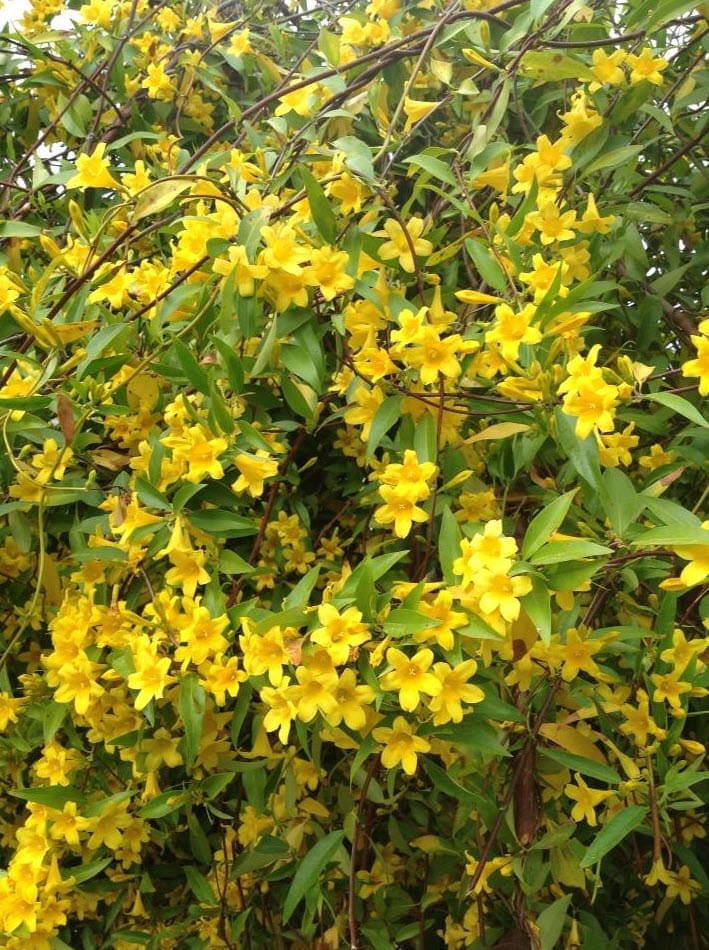
Gelsemium sempervirens
Latin name: Gelsemium sempervirens
Short name: Gels
Common name: Yellow Jasmine | Carolina Jasmine | Wild Woodbine | Evening Trumpetflower | False Jasmine
Primary miasm: Sycotic Secondary miasm(s): Psoric
Kingdom: Plants
Family: Loganiaceae
- Symptomatology
- Remedy Information
- Differentiation & Application
Gelsemium sempervirens is a climbing plant native to the southeastern United States. It contains alkaloids such as gelsemine and sempervirine, which have powerful neurotoxic effects. Ingestion of the plant in crude form can cause paralysis and death.
Traditionally used in herbalism for treating fevers and nervous conditions, though its toxicity limits its application. Gelsemium has been studied for its muscle relaxant and sedative properties in pharmacology.
First proved by Dr. Edwin M. Hale in the United States, mid-19th century (circa 1852), using tincture derived from the fresh root.
Nervous system; motor nerves; eyes; mucous membranes; throat; respiratory tract; occiput; muscles; circulation; bladder.
Profuse urination; sweating; continued motion; open air; bending forward; stimulants.
Emotional excitement; fright; anticipation; bad news; sun and heat; damp weather; mental exertion.
- Argentum nitricum – Both remedies address anxiety and anticipatory states, but Arg-n. is hurried, impulsive, and loquacious, while Gelsemium is drowsy, dull, and slow.
- Aconitum napellus – Also covers fear and sudden illness, but Aconite is acute, panicky, with dry heat and strong thirst. Gelsemium is slow, trembling, and thirstless.
- Phosphoric acid – Both may present with apathy and weakness, but Phos-ac. shows deep emotional collapse and indifference. Gelsemium has more fear and paralytic symptoms.
- Ignatia amara – Emotionally reactive like Gelsemium, but more changeable and spasmodic. Ignatia craves solitude and sighs from grief; Gelsemium is sleepy and paralysed.
- Kali phosphoricum – A nerve remedy also used for mental fatigue, but more suited to long-term exhaustion. Gelsemium suits acute, anticipatory trembling and prostration.
- Complementary: Phosphoric acid, Ignatia
- Antidotes: Coffee, Camphora
- Inimical: Belladonna
- Follows Well: Aconitum, Bryonia
- Precedes Well: Baptisia, Phosphorus
Gelsemium sempervirens is the remedy of paralysis through fear. Its central theme is suppression and dullness—of thought, will, emotion, and muscular activity—induced by fright, anticipation, or grief. The patient is tremulous, passive, and weak, marked by heavy limbs, drooping eyelids, and foggy mind. Its sphere lies in nervous weakness, influenza, headaches, and diarrhoea from emotion. It suits the oversensitive but emotionally reserved patient.
Indispensable for stage fright, exam nerves, labour trembling, and acute viral conditions (especially flu with heaviness, no thirst, and prostration). Use 30C for acute emotional states, or 200C–1M for strong anticipatory complaints. Lower potencies like 6X may be used in fatigue or vertigo.
Mind
- Fear, anticipation, from
- Anxiety, examination, before
- Dullness, mental
- Speech, slow, hesitant
- Memory, weakness of
Head
- Pain, occiput, extends to forehead
- Vertigo, lying, while
- Head, heaviness of
Eyes
- Ptosis
- Diplopia
- Dim vision, before headache
Stomach & Abdomen
- Nausea, anticipation, from
- Diarrhoea, fright, from
- Abdomen, heaviness
Extremities
- Weakness, legs
- Trembling, hands
- Paralysis, sudden, from emotion
Fever
- Fever, no thirst
- Fever, with trembling
- Chill, runs up back
James Tyler Kent – Lectures on Homoeopathic Materia Medica
William Boericke – Pocket Manual of Materia Medica
John Henry Clarke – Dictionary of Practical Materia Medica
Constantine Hering – Guiding Symptoms of Our Materia Medica
Allen & Norton – Encyclopaedia of Pure Materia Medica
